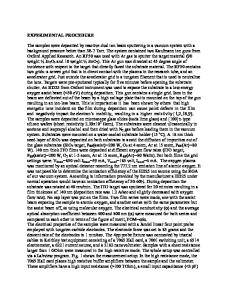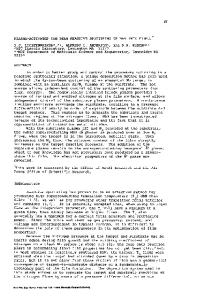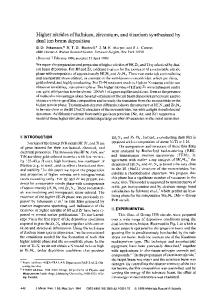Aluminum nitride films synthesized by dual ion beam sputtering
- PDF / 949,761 Bytes
- 5 Pages / 612 x 792 pts (letter) Page_size
- 16 Downloads / 313 Views
Hong-Ying Chen Department of Applied Life Science, Taichung Healthcare and Management University, Taichung County, Taiwan 413, Republic of China
Chih-Hsuan Cheng Department of Materials Engineering, National Chung Hsing University, Taichung, Taiwan 402, Republic of China
Jian-Hong Lin Department of Materials Science and Engineering, National Tsing Hua University, Hsinchu, Taiwan 300, Republic of China
Han C. Shiha) Department of Materials Engineering, National Chung Hsing University, Taichung, Taiwan 402, Republic of China; and Department of Materials Science and Engineering, National Tsing Hua University, Hsinchu, Taiwan 300, Republic of China (Received 28 May 2004; accepted 13 August 2004)
Aluminum nitride films were deposited by varying the voltages of argon ion beams from 400 to 1200 V in dual ion beam sputtering. The crystal structure, microstructure, and elemental distributions of the aluminum nitride films were analyzed by x-ray diffraction, field emission scanning electron microscopy, and secondary ion mass spectroscopy, respectively. The aluminum nitride films exhibited the 〈002〉 preferred orientation at an optimal ion beam voltage of 800 V. The orientation changed to a mixture of {100} and {002} planes above 800 V, accounting for radiation damage. The thickness of the film increases with increasing ion beam voltage, reaching a steady state value of 210 nm at an ion beam voltage of 1200 V. Under optimal condition (800 V), the c-axis orientation of the aluminum nitride 〈002〉 film was obtained with a dense and high-quality crystal structure.
I. INTRODUCTION
Aluminum nitride (AlN) is a III-V semiconductor compound with a hexagonal wurtzite crystal lattice structure and is a promising material for use in microelectronics packaging owing to its high thermal conductivity, a moderate dielectric constant and a thermal expansion coefficient that matches that of silicon.1–3 Additionally, caxis-oriented AlN thin films have potential applications in high-frequency surface-acoustic-wave devices because they have a large electromechanical coupling constant and high acoustic velocity.4 AlN films are grown by chemical vapor deposition,5,6
a)
Address all correspondence to this author. e-mail: [email protected] DOI: 10.1557/JMR.2004.0451 J. Mater. Res., Vol. 19, No. 12, Dec 2004
http://journals.cambridge.org
Downloaded: 13 Mar 2015
reactive sputtering deposition,7 plasma-assisted molecularbeam epitaxy,8 laser ablation deposition,9 and ion-beamassisted deposition.2,10 Dual ion beam sputtering (DIBS) uses metallic or compound targets to produce a sputterdeposited film, while the growing film is concurrently bombarded during deposition with a second ion beam. 10,11 The bombardment process can strongly modify the structural and chemical properties of the resulting film and the incident particles may also become part of the growing film during deposition. Although the variation of reactive nitrogen ion-beam energy/voltage in the DIBS technique has been investigated,10,11 the variation of argon ion-beam energy has
Data Loading...











